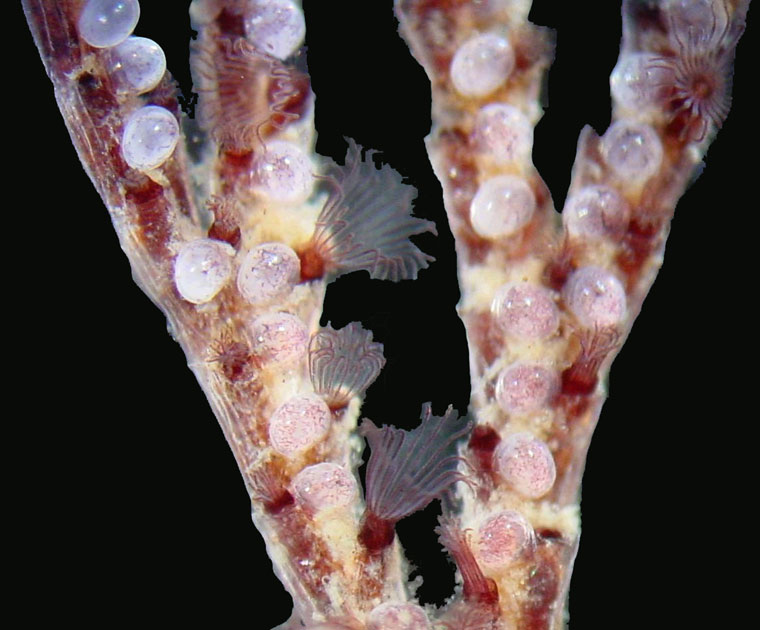Adaptations
Bugula neritina is a sessile bryozoan that belongs to a clade of aquatic protostomes (Fuchs et al. 2011). An organism is classified as a protostome if its mouth develops before the anus from the blastopore (Merriam Webster 2014). Bugula neritina form erect colonies through asexual reproduction. The colonies form bushy, branching tufts that are a dark red-purple or purple-brown in color. The organism can grow as tall as 15 cm (Cohen 2011).
Colonies consist of individual zooids which contain soft polypides. The polypides are surrounded by a protective covering called a zooecium. The zooecia face the same direction and are stacked one-on-top of the other. The front portion of a zooecium contains a flexible membrane while the upper outer portion of a zooecium is a sharp point. One branch is made up of two-staggered rows of zooecia. Unlike other Bugula species, Bugula neritina does not have an avicularia which is an element that opens and closes in a jaw-like fashion (Cohen 2011).
 During the larval stage of reproduction, Bugula
neritina have blastemic tissues that are used during the
metamorphosis stage to produce the adult bryozoans.
These blastemic tissues are established from
predetermined cells in the Bugula neritina. Bugula
neritina also encompass a lophotrohcozoan feeding
structure (Fuchs et al. 2011). Around the
lophophore, the
organism has between 20-24 white, translucent
tentacles in a crown shaped U. These tentacles are
long and rigid and have cilia that line them(Cohen 2011,
Merriam Webster 2014). These tentacles flex
creating a current which brings in water into the
organism (Global Invasive Species Database, 2005). The
tentacles aide in bringing in particles of food in a
process called filter feeding, similar to
Pollicipies polymerus. Bugula neritina
consumes microscopic plankton (Cohen 2011).
During the larval stage of reproduction, Bugula
neritina have blastemic tissues that are used during the
metamorphosis stage to produce the adult bryozoans.
These blastemic tissues are established from
predetermined cells in the Bugula neritina. Bugula
neritina also encompass a lophotrohcozoan feeding
structure (Fuchs et al. 2011). Around the
lophophore, the
organism has between 20-24 white, translucent
tentacles in a crown shaped U. These tentacles are
long and rigid and have cilia that line them(Cohen 2011,
Merriam Webster 2014). These tentacles flex
creating a current which brings in water into the
organism (Global Invasive Species Database, 2005). The
tentacles aide in bringing in particles of food in a
process called filter feeding, similar to
Pollicipies polymerus. Bugula neritina
consumes microscopic plankton (Cohen 2011).
To see how the Bugula neritina fit into the benthic
marine good web, visit
The
Smithosian Environmental Research Lab Benthic Ecology
Lab!